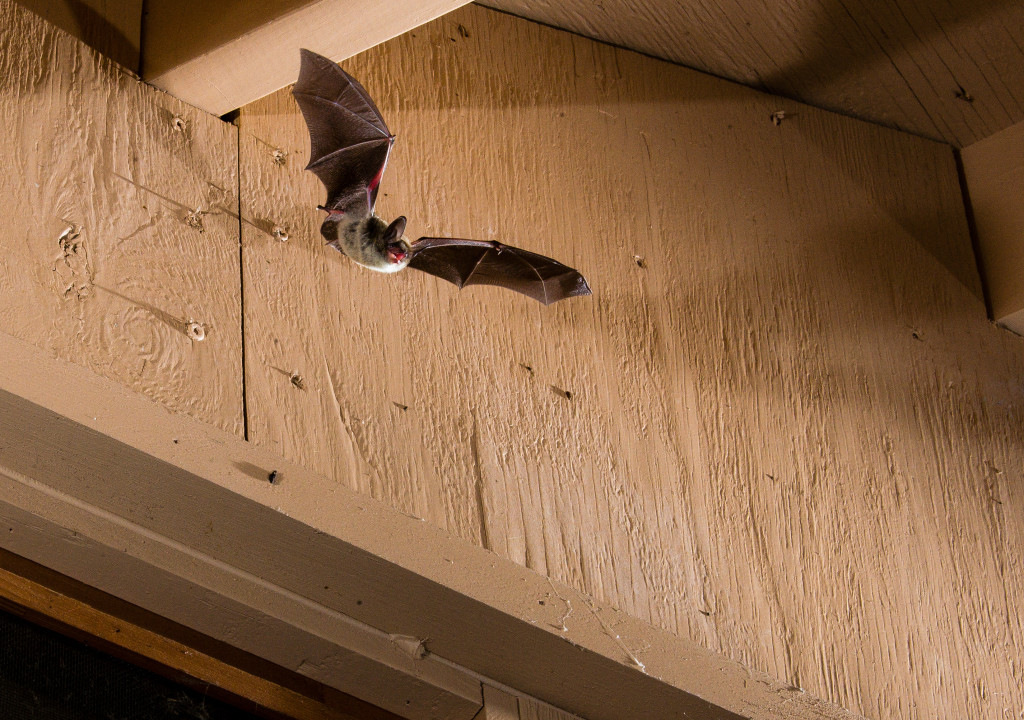Enlarge

Photo by Eric Fowler
By Olivia DaRugna
Bats are usually in the spotlight only around Halloween and during Bat Appreciation Week. However, we are going to break the norm, because August is a great time to observe the world’s only true flying mammal. So, before homework and school sports start back up, get outside in the early evening to look up at the sky for glimpses of these evening aerial acro-bats — pun intended — as they quickly dive and turn to catch their prey.
Nebraska is home to 13 species of bats, of which nine are listed as at-risk species in the Nebraska Natural Legacy Plan due to varying threats to their populations, such as white-nose syndrome. As part of the North American Bat Monitoring Program, volunteers, biologists and landowners use acoustic detectors to survey for bats across the state. The detectors allow biologists to determine what species are present using the frequency and pattern of sound recordings. The most common species in the state are big brown bats, eastern red bats, hoary bats and silver-haired bats.

Worldwide, over 300 species of fruit, including bananas, avocados and mangos, rely on bats for pollination. Bats also help spread the seeds of nuts, cacao (main ingredient in chocolate) and agave. I don’t know about you, but I don’t want to think about a world without these foods. Although Nebraska does not have any fruit-pollinating bats, our bats here are insectivores, making them incredible pest controllers.
As the night falls, bats leave their roosts in trees and crevices to hunt for prey. Instead of relying on their poor eyesight, they use echolocation to help them navigate and find prey. As the bats fly, they emit calls – which are out of hearing range for humans – and the returning echoes let them know what is ahead of them, like the size and direction of a flying insect. Some bats that forage in open areas, such as the big brown bat, are considered “shouters,” producing a call that if we could hear it, would be as loud as a smoke alarm. Other species that hunt among trees, such as the northern long-eared bat, produce a quieter sound that if humans could hear, would be about the level of a person talking. Echolocation makes bats effective predators. A single bat can eat thousands of insects in one night.

Regardless of where you are, whether it is in your backyard or camping at a park, you can enjoy viewing bats as they fly overhead catching insects. Areas near water or wooded edges can be great places for observing bats. To view bats, get outside in the evening around dusk, before the sky gets too dark. While reclining in your lawn chair, watch for the bat’s silhouette and quick movements against the remaining light in the sky. As the sky gets darker, the silhouettes become more difficult to see. Although most bat calls are outside human hearing range, you may still hear a few of their high-pitched squeaks throughout the night.
Attract Bats to Your Yard
Creating a bat-friendly yard is a great way to enjoy bats throughout the summer. Similar to attracting birds and pollinators, attract insects to attract hungry bats by planting native flowers, shrubs and trees, and avoiding pesticides. If there are no dead trees around for the bats to roost in, consider installing a bat house following the tips by Bat Conservation International.
When October comes around and the spotlight is deservingly back on these great creatures, remember bats are not spooky. They are incredible pest controllers and pollinators for some of our favorite summer fruits.

Wildlife Viewing Events
Nature at Nightfall, August 18 at Platte River State Park — Discover a variety of nocturnal wildlife from amphibians, to moths, to bats at this family-friendly event.
Bird banding stations at Chadron State Park and Wildcat Hills Nature Center will open in mid-August. You can stop by the Bird Conservancy of the Rockies stations to learn about and view the birds banded Wednesday through Sunday. To learn more, click here.
The post August Wildlife Viewing – Bats appeared first on Nebraskaland Magazine.
















